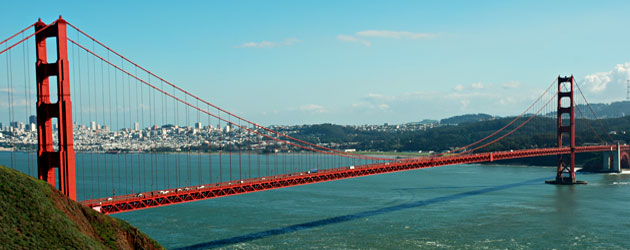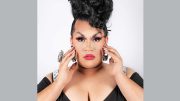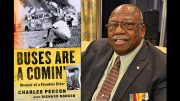
SoMa is most markedly defined by what it stands for: it’s the neighborhood south of Market Street.
Photo: Andrew Collins
By: Andrew Collins*/Special to The Rainbow Times—
Encompassing a vast, architecturally and demographically diverse tract of central San Francisco (www.sanfrancisco.travel/lgbt) that extends from the Mission District to the bay, SoMa is most markedly defined by what it stands for: it’s the neighborhood south of Market Street. Within this urban swath containing everything from shiny new loft condos to vintage refurbished warehouses, you’ll find a vibrant stretch of waterfront on the bay, the culturally dynamic Yerba Buena Gardens complex, several stylish hotels, the heart of the city’s leather-and-Levi’s queer scene, a few of the longest-running gay dance clubs in the country, and some of the city’s trendiest restaurants and cafes.
Day or night, you’ll find plenty to see and do in SoMa. Although LGBT tourists often look upon the Castro as San Francisco’s must-see neighborhood, the SoMa gay scene – concentrated around Folsom and Harrison streets near the confluence of the 101 and I-80 freeways – has been humming along for even longer, and it offers an impressively eclectic, creative, and edgy vibe that appeals to everyone from queer artists to sophisticated foodies to leather-and-fetish aficionados. [pullquote]Encompassing a vast, architecturally and demographically diverse tract of central San Francisco that extends from the Mission District to the bay, SoMa is most markedly defined by what it stands for: it’s the neighborhood south of Market Street. [/pullquote]
At the upper (northeastern) end of SoMa, closer to the Financial District and waterfront, the neighborhood is more touristy and traditional. This section is anchored by the mammoth Moscone Convention Center, named for former mayor George Moscone who was—with iconic gay rights activist Harvey Milk – assassinated in 1978. Business travelers and tourists of all types are drawn to the several museums, upscale shopping malls, and luxury hotels in this area.
It’s about a 2.5-mile walk (allow 45 minutes to an hour) to get from the bay to southwestern SoMa’s border with the Mission District, and the section in the middle – from about 4th to 8th streets—can be a little Spartan and less interesting (though still quite safe). At night, consider cabbing it if trying to get from one of the hotels up near Yerba Buena Gardens to the gay-bar and hip dining district.
SoMa Sightseeing Highlights
Right where Market Street ends on the bay, at Embarcadero, you’ll find San Francisco’s Ferry Terminal Building, which contains a slew of great restaurants and food shops. The gorgeously restored 1898 building overlooks San Francisco Bay—ferry boats to Oakland, Sausalito, Tiburon, and elsewhere still leave from the piers behind the building. Inside, you’ll find merchants and restaurants proffering a dizzying variety of mouthwatering morsels, including wines, olive oils, sausages, cheeses, coffee and tea, sweets—you name it. There’s also a terrific farmers market early on Tuesdays, Thursdays, and Saturdays. Across street, stop inside the small but very interesting San Francisco Railway Museum, which contains exhibits on the city’s famed cable cars and F-line streetcars.
The contemporary Yerba Buena Gardens comprises terraced gardens and waterfalls, sculptures, an arts center with performance halls and art galleries, cafes, a children’s museum, and an ice-skating and bowling center. Taking up two large city blocks, this complex also contains the huge and modern Metreon shopping mall and movie plex, and several intriguing museums: the Museum of the African Diaspora, the Cartoon Art Museum, the Contemporary Jewish Museum, and the California Historical Society. Across from Yerba Buena, the outstanding San Francisco Museum of Modern Art (SFMOMA) is closed during a major expansion until early 2016, but the excellent SFMOMA museum store is still open, and in the meantime, the museum is presenting a number of rotating exhibits at other venues around the city.
The neighborhood has quite a few commercial art galleries, too – 111 Minna Gallery and Terra Gallery are notable venues not too far from Yerba Buena Gardens, while down near the Mission, the SoMa Arts Cultural Center presents provocative exhibits throughout the year—they’re often specifically of queer interest. Several other galleries are located along Howard and Folsom streets in this part of the neighborhood.
Restaurants
SoMa’s upper reaches abound with noteworthy restaurants, many of them located in the upscale hotels mentioned below. In the Ferry Terminal Building, don’t miss Gott’s Roadside for delicious burgers, seafood, and garlic fries; and the Slanted Door for upscale Vietnamese cuisine.
Many of the top tables in SoMa are down in the lower end, however, amid the neighborhood’s gay bars. A culinary high point is Radius San Francisco (www.radiussf.com), a stylish high-ceilinged storefront space specializing in gorgeously plated, locally sourced California cuisine and fine regional wines – on warmer days, dine on the patio. With vintage photos and framed Life Magazine covers on the wall, old-school Rocco’s (www.roccoscafe.com) is a lively, gay-popular spot for well-prepared classic red-sauce Italian fare, from linguine with sautéed calamari to chicken marsala with pasto pesto. Along buzzy 11th Street, check out Bergerac (www.bergeracsf.com) – a glamorous space with craft cocktails and creative small-plates snacks (Asian duck tacos, shrimp fritters) – and Bar Agricole (www.baragricole.com), known for stellar mod-American cooking. [pullquote]Many of the top tables in SoMa are down in the lower end, however, amid the neighborhood’s gay bars. [/pullquote]
A fun place to dine out with friends, Fondue Cowboy (www.fonduecowboy.com) offers a novel take on the old-school dining classic. These aren’t your typical fondues – try the Quick Draw (Manchego cheese, white wine, roasted red pepper, roasted garlic) or High Noon (white chocolate with balsamic-strawberry puree). Fans of Asian cuisine should check out Basil Canteen (www.basilthai.com), a contemporary Thai restaurant in a handsome warehouse space with exposed-brick walls – creative dishes like grilled coconut-marinated pork skewers and stir-fried skirt steak with a chili-brandy sauce are among the offerings. Also notable is Izakaya House (www.izakayahouse.com), a convivial late-night option for first-rate sushi and Japanese fare.
Gay Bars and Nightclubs
SoMa’s lower section is home to some of the city’s most historic gay bars, including the End Up, which has been going strong since 1973 – it was featured famously in Armistead Maupin’s Tales of the City series. The crowd these days is a catch-all: queer and straight clubbers of all ages, from college students to some who may very well have been here on opening night four decades ago. Also legendary is The Stud (www.studsf.com), which is nearing its 50th birthday and is justly famous for its Meow Mix gender-bender Tuesday variety shows and is fun for dancing on weekends, too.
The neighborhood has long been one of the world’s leading hubs of gay leather culture – it plays host to the infamous Folsom Street Fair (www.folsomstreetfair.org) each September as well as the Up Your Alley fetish fair in late July. The renowned San Francisco Eagle (www.sf-eagle.com), which shuttered for a time and was nearly redeveloped as an upscale restaurant (causing a huge community kerfuffle), reopened early in 2013 and is as invitingly dark and saucy as ever, if less strictly leather-oriented than it used to be. These days you’ll find a diverse crowd, including otters and bears, hipsters, leather daddies, and even some twinks. Other good bets along Folsom Street include the ultra-cruise-y Powerhouse (powerhouse-sf.com), with such creative theme nights at Nipple Play and Kink Salon, and the venerable Hole in the Wall Saloon (www.holeinthewallsaloon.com), which has long billed itself “a nice little queer bar for filthy bikers and loudmouth punks.” Nearby, the Lone Star Saloon (www.lonestarsf.com) is a beloved neighborhood bar with a good-size patio, great happy hour drink specials, and a furry all-ages crowd.
11th Street between Folsom and Harrison has gradually become SoMa’s hippest bar-hopping block, with a slew of notable restaurants, lounges, and clubs, including the gay nightspot BeatBox (www.beatboxsf.com), an eclectic space for dancing that offers everything from country music on Tuesdays to Tea-Rex T-dances on Sundays; and DNA Lounge (www.dnalounge.com), a huge dance club and live-music venue with a mixed crowd and an adjacent pizza restaurant that’s handily open 24/7.
Nearby, the massive 1015 Folsom (1015.com) nightclub has some highly popular circuit-style parties and raves—check the calendar for details. Cat Club (www.sfcatclub.com) is another cool dance space with different theme nights, many with a strong queer following—Throwback Thursdays and Wednesday’s Bondage A-Gogo are two of the city’s better midweek clubbing adventures.
Where to Stay in SoMa
Across the street from the Ferry Terminal Building, the sleek and contemporary Hotel Vitale (hotelvitale.com) is part of the stylish Joie de Vivre chain; many of its airy rooms overlook the bay, and there’s a great little urban spa on-site. Just a block away and occupying part of a historic YMCA building, the Harbor Court (harborcourthotel.com) is one of two SoMa members of the gay-popular, San Francisco-based Kimpton brand. This 131-room property has a large ground-floor “living room” off the lobby with a fireplace and plenty of comfy armchairs – it’s a lovely spot to while away an afternoon. The design-driven W San Francisco (www.wsanfrancisco.com) rises 31 stories above Yerba Beuna Gardens, its rooms chockfull of cushy amenities, and its TRACE restaurants drawing a see-and-be-seen crowd for drinks and dining.
One of the better deals in the neighborhood, the gay-popular Mosser Victorian (www.themosser.com) is a smartly renovated redbrick beauty right in the heart of the neighborhood. Next door is Kimpton’s other SoMa property, the dapper Palomar San Francisco (www.hotelpalomar-sf.com), which has a decidedly plush and modern vibe, its rooms outfitted with gourmet minibars and iPod docks.
Down closer to gay nightlife are several mid-range chain properties, the best of which are the Holiday Inn San Francisco-Civic Center (www.ihg.com) and the retro-decorated Best Western Plus Americania (www.americaniahotel.com). Next to the latter, the arty, eco-conscious, and still reasonably priced Good Hotel (www.thegoodhotel.com) is, indeed, a good place to lay your head for the night. Strictly for those on a tight budget, the dive-y but economical (rates start under $100) San Francisco Inn (www.sanfranciscoinn.com) is a bare-bones motel with free parking that works well in a pinch. And you can’t beat the location for SoMa nightlife – it’s right by the Stud nightclub and less than three blocks from most of the other gay clubs in the neighborhood.
*Andrew Collins produces the site GayTravel.About.com and contributes to many other travel magazines and websites. He can be reached care of this publication or at OutofTown@qsyndicate.com.








Doh, wrong cut-and-paste, Wicked Grounds can be found at http://www.WickedGrounds.com